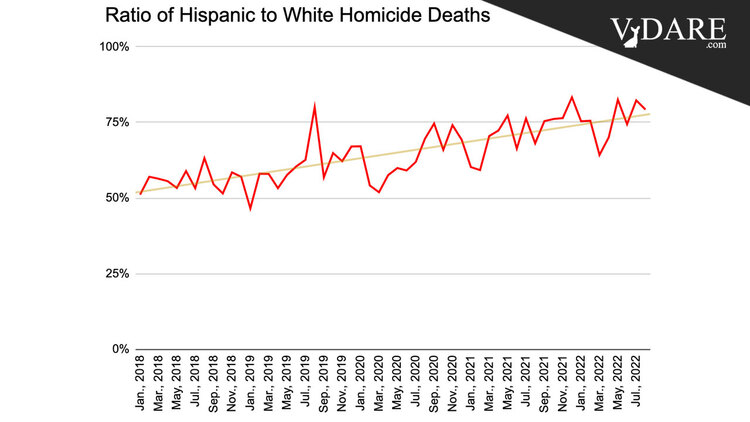From the Washington Post opinion section, a piece trying to get across the message that Hispanics have been behaving better in this century (especially after 2008 sent a lot of marginal Latinos packing). But you can’t just come out and say that blacks should try to do better too, so it’s hard to say if anybody will grasp the point.
The Hispanic experience in jail looks more like the White one now
By Keith Humphreys
March 9, 2023 at 4:39 p.m. ESTKeith Humphreys, a professor of psychiatry at Stanford University, served as senior policy adviser in the White Office of National Drug Control Policy in the Obama Administration.
Many politicians, activists and academics have long characterized the criminal justice system as biased against Black and Brown people, with the catchall term “Brown” usually referring to Hispanics. But the latest data shows that Hispanics’ experience of criminal justice and law enforcement is becoming increasingly similar to that of Whites, not Blacks. …
Consider the recently released U.S. Bureau of Justice Statistics data on people under criminal justice supervision, meaning being confined in a jail or prison or being on probation or parole. At the end of 2021, 861,000 of the United States’ 63 million Hispanics were under criminal justice supervision, a rate of 1,372 per 100,000. This is within an eyelash of the non-Hispanic White rate of 1,324 per 100,000 (2.606 million of 197 million).
It doesn’t mean the two groups’ experiences are identical—White Americans have a higher rate of serving time in local jails, for example, whereas Hispanics have a higher rate of serving time in state or federal prisons—but relative to the enormous disparities of a generation ago, the convergence is remarkable. The Black rate of being under criminal justice supervision has also declined in recent decades, but at 3,773 per 100,000 remains almost triple that of White and Hispanic Americans.
Policing data shows other White-Hispanic parallels. The proportion of police who are Black stayed essentially flat at around 11.6 percent from 1997 to 2020 while the proportion who are Hispanic increased from 7.8 percent to 14.2 percent. And while 57 percent of Black officers believe that fatal encounters between police and Black suspects are the result of broader problems in how police departments relate to Black communities, 72 percent of both Hispanic and White cops consider such fatalities isolated incidents not reflecting underlying problems, according to Pew Research data.
Gallup poll data shows that only 27 percent of African Americans have significant trust in police vs. 56 percent of White citizens. Hispanics are again much closer to White people, at 49 percent. Hispanics’ higher trust in police is more understandable in light of the fact that increasingly more police are Hispanic and that unarmed Hispanic suspects are far less likely to be fatally shot by police than either Black or White ones, according to an analysis of a Post database by independent journalist Kevin Drum.
How should criminal justice reform proceed in light of this confluence of White and Hispanic experiences and viewpoints?
First, we should be less pessimistic about the ability of America in general and the criminal justice system in particular to change. The Council on Criminal Justice documented that in 2000, relative to White people, Hispanics were about 1.5 times as likely to be on probation, more than twice as likely to be in prison or jail, and more than three times as likely to be on parole. The closing of these gaps over a generation should fuel realistic optimism about the work that remains.
Second, those reformers who spin a decreasingly plausible narrative about the shared fate of Black and Brown people in the criminal justice system should follow the lead of organizations like Black Lives Matter and highlight the uniquely pervasive and persistent effects of anti-Black racism. If we want an equitable criminal justice system, we must implement policies tightly tailored to helping Black Americans avoid both crime and incarceration.
Third, as Hispanics have fewer negative contacts with the criminal justice system, are increasingly employed by it and trust it, they will probably become less energized about reforms that are pushed in the name of reducing prejudicial treatment. Criminologist John Pfaff recently found that reform-seeking liberal prosecutors have lower electoral success in majority Hispanic counties than in majority Black counties.
Keep in mind that incarceration is a lagging indicator.
Unfortunately, Hispanics have been behaving worse during the Racial Reckoning. This graph below is the ratio of the number of Hispanic homicide victims counted by the CDC divided by the number of white homicide victims for each month from January 2018 through August 2022. (This is not per capita but a simple count of dead bodies.) 
To some extent, the steep upward slope is due to the growth of the Hispanic population and the aging of the white population. But still… this is not a good trend.
Hispanics are also becoming worse drivers lately relative to whites:













